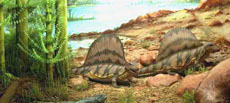 |
 |
 |
 |
 |
Produced
by the Population Genetics and Evolution class, Furman University |
||||
 |
 |
 |
 |
 |
Produced
by the Population Genetics and Evolution class, Furman University |
||||
 |
Eryops |
 |
||
| Eryops
is an early amphibian typical of the temnospondyl group, a large creature
that grew to be around 5 feet long and 200 pounds (Virtual Fossil Museum
2010). It had a particularly large head relative to its body size, measuring
to about 2 feet (Wikipedia 2009). Eryops was believed to inhabit
swamps, and was one of the largest land animals of the Permian (Virtual
Fossil Museum 2010). Eryops represents an important step in evolutionary
history, marking the gradual transition animals made from water to land.
A stronger, thicker bone structure allowed Eryops to support
its weight and venture onto land (Pilgrim 2004). Lungs allowed them to
breathe air, but as their rib cages could not expand to draw in air, they
likely moved the floor of their mouths up and down to pump air into the
lungs (Pilgrim 2004). Eryops also had a rudimentary ear evolved
from vestigial fish jawbones—they could hear airborne sound (Pilgrim
2004). Although the fossils indicate that Eryops had significant
muscle development, they were not fast creatures on land or in the water;
their bodies were low from the ground, and they had thick, short limbs
and tails (Wikipedia 2009). Instead, as the positions of their eyes and
nostrils suggest, they used stealth to hunt prey (Wikipedia 2009). Page by LinLin Zhao |
 |
| Eryops fossil. Photo from www.palaeos.com | |
| Pilgrim T. 2004. Temnospondyli: Euskelia. www.palaeos.com. Accessed March 15, 2010. Virtual Fossil Museum. 2010. Eryops. www.fossilmuseum.net. Accessed March 15, 2010. Wikipedia. 2009.
Eryops. Accessed March 15, 2010. |